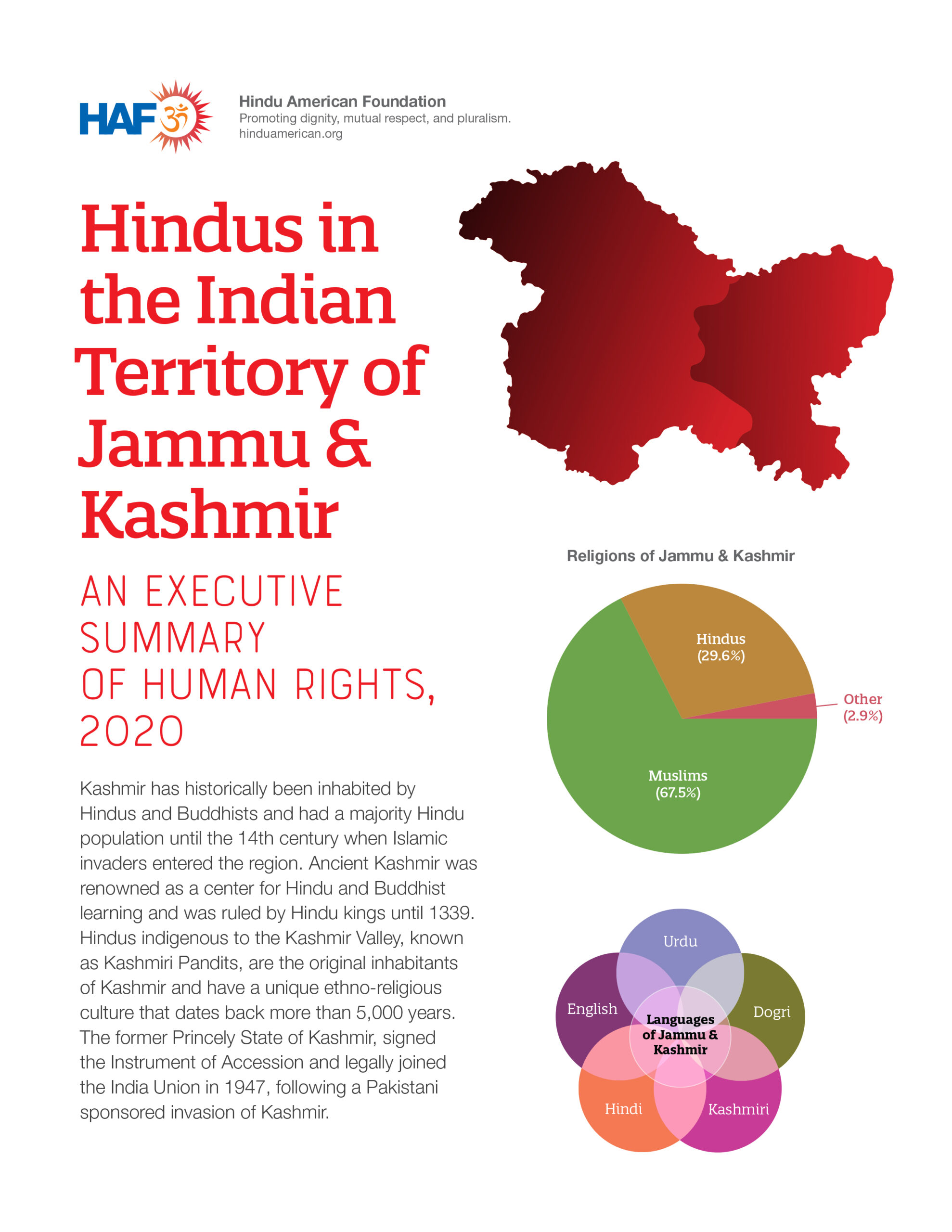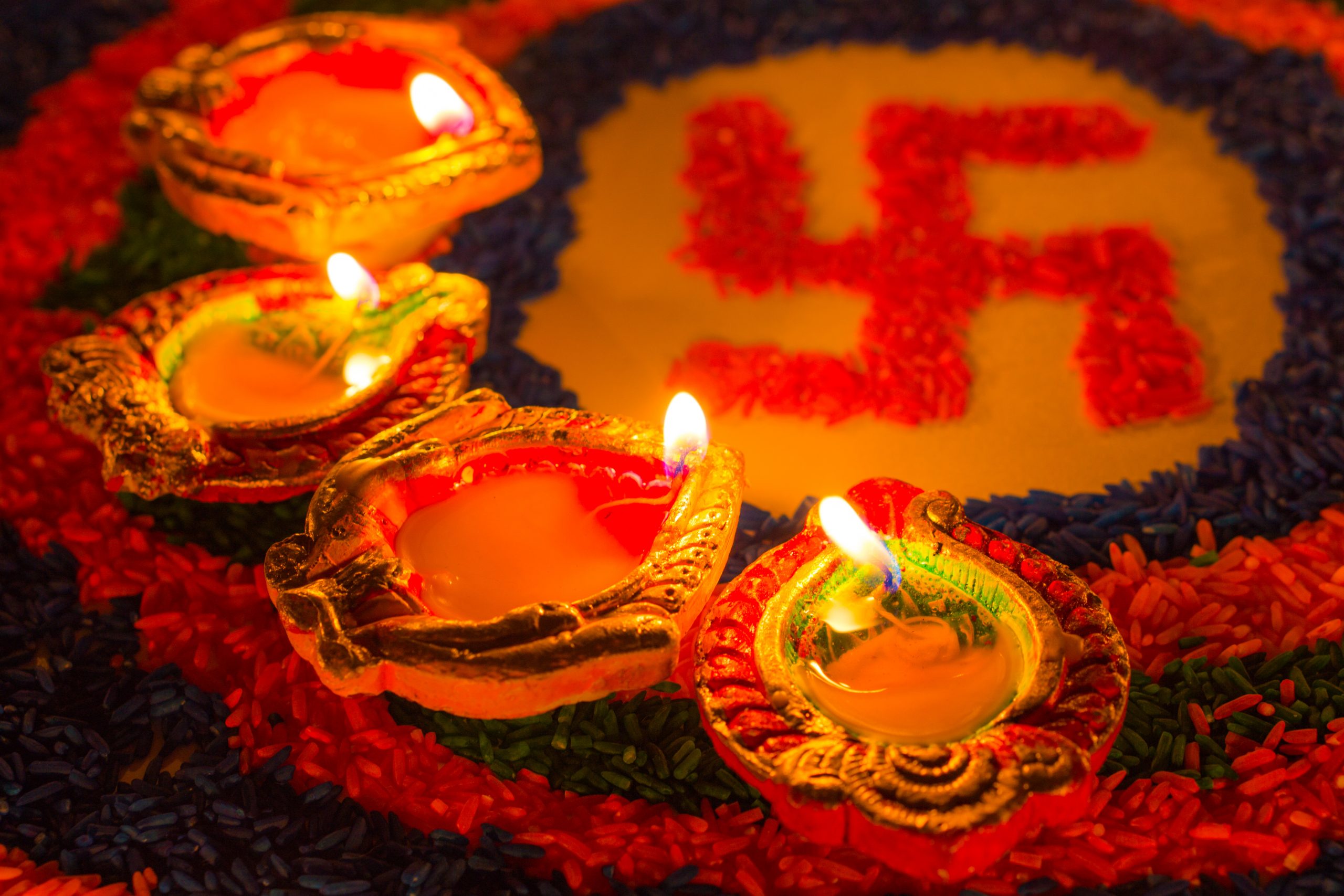Kashmir has historically been inhabited by Hindus and Buddhists and had a majority Hindu population until the 14th century when Islamic invaders entered the region. Ancient Kashmir was renowned as a center for Hindu and Buddhist learning and was ruled by Hindu kings until 1339. Hindus indigenous to the Kashmir Valley, known as Kashmiri Pandits, are the original inhabitants of Kashmir and have a unique ethno-religious culture that dates back more than 5,000 years. (Kak, 1993)
Following waves of Islamic invasions, numerous foreign origin Muslim rulers occupied Kashmir until 1819. Under Muslim rule, Hindus faced periods of persecution resulting in several mass migrations from Kashmir. (Kak, 1993) Sikhs gained control over the region in 1819 and ruled Kashmir until 1846, followed by the Hindu Dogra (an ethnic group native to the Jammu region in the state) reign from 1846 to 1947. (Kak, 1993)
Kashmir’s Accession to India
The Princely State of Kashmir, which was ruled by the Dogra king Hari Singh at the time of partition in 1947, joined the Indian Union after Pakistan’s armed forces orchestrated an invasion of Kashmir using Pashtun “tribesmen” and regular military personnel. The invading tribal militia committed mass atrocities against the people of Kashmir, including massacres of Muslims and Hindus, and the capture of non-Muslim women. (Khan, 2017) Thousands of Hindus and Sikhs were forced to flee POK while thousands more were killed. On November 25, 1947, over 20,000 Hindus and Sikhs were slaughtered by the invading tribal militia and Pakistani army in the city of Mirpur in what became known as the Mirpur Massacre. (Chaudhary, 2013; Sarkar, 2016) Violence was also carried out by Sikhs and Hindus against Muslims during this time in Jammu. (Sarkar, 2016)
There are no Hindus remaining in POK due to killings and forced conversions, though it is still home to ancient Hindu sacred sites, such as Sharda Peeth, one of the three holiest pilgrimage sites for Kashmiri Hindus.
Following the Pakistani offensive, Hari Singh signed the Instrument of Accession formalizing Kashmir’s legal accession to India. (Haqqani, 2003) The accession was also approved by the largest and most popular Kashmiri political party, the All Jammu and Kashmir National Conference, led by Sheikh Mohammed Abdullah. Once Kashmir legally joined India, Indian forces were deployed to stop the advancing Pakistani military, leading to a full-scale war between the two countries. (Haqqani, 2003)
Following the intervention of the Indian military and with Pakistan forces in retreat, India was prompted by Lord Atlee, the prime minister of U.K., to take the case of the aggression by Pakistan in Kashmir to the United Nations, and in April 1948, India then sought the intervention of the United Nations (UN). (Sazawal, 2021) The UN Security Council passed Resolution 47 which required Pakistan to first withdraw all its military personnel and “tribesmen” from the state as a necessary precondition to holding a plebiscite. (Subbiah, 2004) In August 1948, however, the UN Commission on India and Pakistan (UNCIP) found that Pakistan had instead increased its military presence in Kashmir. (Subbiah, 2004)
After a ceasefire in January 1949, Pakistan remained in control of approximately one-third of the state while the remaining two-thirds were incorporated into India under Article 370 of India’s Constitution, which along with Article 35A defining residential and property rights, granted a special status to the state. Specifically, it restricted the Indian Parliament’s legislative power over Jammu and Kashmir to defense, foreign affairs, and communications, and it also placed a restriction on people moving from other parts of India to the state. (Fotedar et al., 2002)
Subsequently, local elections were held in Indian Kashmir in 1951 where the Muslim led National Conference won a resounding victory. And in 1956, the Jammu and Kashmir Constituent Assembly voted to approve the merger of Kashmir with India via the Instrument of Accession. (Ganguly, 1998)
China then took control over 16,500 sq. miles of Kashmir by occupying Indian territory during the 1962 Indo-China War and through a boundary agreement with Pakistan in 1963.
Ethnic Cleansing of Kashmiri Pandits
Starting in 1984, political leaders in the state, such as Ghulam Mohammad Shah, began inciting Muslims, claiming that Islam was in danger. This led to violent riots targeting Kashmiri Pandits in South Kashmir and Sopore, where Hindus were killed, and several temples and properties were destroyed. Subsequent anti-Hindu riots in Anantnag in 1986 resulted in the destruction of several Kashmiri Hindu homes and properties and the flight of many Hindu families out of the Valley. (EurAsian Times, 2017)
The anti-Hindu violence culminated in the events of 1989-1990, when more than 350,000 Kashmiri Hindu Pandits (95% of the Valley’s Hindu population) were ethnically cleansed from the Valley by Muslim extremists. The forced displacement was accompanied by a campaign of violence and destruction in the Valley. (Ramachandran, 2020; Rao, 2019, ) Kashmiri Pandit groups estimate that since 1989, nearly 105 educational institutions run by Kashmiri Hindus have been burned down or destroyed, hundreds of temples and religious sites damaged or demolished, 14,430 businesses and shops destroyed, and more than 20,000 Kashmiri Hindu homes destroyed, looted, or occupied. (Kashmir News Network, n.d.)
According to official statistics from the state government, 208 Hindu temples have been destroyed or damaged since the start of the violence in 1989. Other estimates assert that the numbers are much higher. A recent survey of Hindu shrines in Kashmir found that 347 Hindu religious sites were destroyed or damaged, while another organization asserts that 550 temples were destroyed or damaged. (Ashiq, 2012; State Times, 2015)
Selective killings, aimed at intimidating the community and forcing them to leave, led to the murder of over 1,100 Kashmiri Pandits, according to Pandit groups. (Kashmir News Network, n.d.) While India’s National Human Rights Commission (NHRC) stopped short of calling the cleansing of Kashmiri Hindus a genocide, they observed that the crimes amounted to near genocide. (Sharma, 2014)
The violent campaign targeting Hindus in Kashmir was organized and systematic, and included massacres, rape, threats, and intimidation. Public announcements were placed in newspapers, sermons made in mosques, and posters hung on houses ordering all Kashmiri Hindus to leave the Valley, threatening violence if they did not and calling on Muslims to take up jihad against non-Muslims. (Gill, 2003; Gupta, 2005; Tikoo, 2012) Letters were sent to Pandit homes stating, ‘We order you to leave Kashmir immediately, otherwise your children will be harmed — we are not scaring you but this land is only for Muslims, and is the land of Allah. Sikhs and Hindus cannot stay here.’ The threatening note ended with a warning, ‘If you do not obey, we will start with your children. Kashmir Liberation, Zindabad.’” (Tikoo, 2012)
Similarly, according to American journalist Hillary Brenhouse, Kashmiri Pandits became easy targets for Islamist militants, and “[a]nti-Hindu rhetoric was broadcast at weekly prayers, [while] dozens were murdered.” (Brenhouse, 2013) A common threat to Hindus broadcast from the mosques was “Ralive, tsalive, ya galive” (convert to Islam, leave, or die). (Tikoo, 2012)
In addition, mobs of tens of thousands of Kashmiri Muslims took to the streets chanting slogans, including death to Kafirs (non-Muslims or non-believers), and “Kashmir banawon Pakistan, Bataw varaie, Batneiw saan” (“We will turn Kashmir into Pakistan, with Kashmiri Hindu women, but without their men”). (Gigoo & Sharma, 2015) Similarly, armed members of militant groups marched publicly to intimidate the Pandit community. (Brenhouse, 2013) Noted journalist Rahul Pandita asserted that along with Islamists, many ordinary Kashmiri Muslims participated in the ethnic cleansing of the Pandits. (Raina, 2013)
One elderly Kashmiri Hindu recounted, “Our people were killed. I saw a girl tortured with cigarette butts. Another man had his eyes pulled out and his body hung on a tree. The armed separatists used a chainsaw to cut our bodies into pieces…” (Sharma, n.d.)
In order to accommodate the large numbers of Hindus fleeing the Valley, the Indian government set up semi-permanent camps for the displaced in Jammu and New Delhi. (Thelwell, 2020) Despite being forcibly displaced from the Kashmir Valley, Kashmiri Pandits continue to be labeled as “migrants” by the Indian government, instead of Internally Displaced Persons (IDPs). The term “migrant” is problematic as it implies that Hindus left Kashmir of their own volition rather than being forced to flee due to violence, threats, and intimidation.
Pakistan’s Proxy War in Kashmir
Starting in 1989, Islamic terrorism, funded and supported by Pakistan’s military and powerful Inter-Services Intelligence (ISI) agency, engulfed the Kashmir Valley. Although the violence initially targeted Kashmiri Pandits in the Valley, Pakistan sponsored Islamic militants expanded their operations to attack Hindu, Sikh, and Muslim civilians throughout the state, in violation of UN Covenants governing terrorism. (University of Minnesota Human Rights Library, 2001, 2002)
According to South Asia scholar and former Pakistani ambassador to the U.S., Husain Haqqani, the ISI supported jihad in Kashmir as an instrument of state policy and the violence was “rooted in the ideology of Pakistani Islamists, carefully nurtured for decades by the Pakistani military.” (Haqqani, 2005) Pakistan sponsored terror groups active in Kashmir, such as Lashkar-e-Taiba (LeT), Hizb-ul Mujahideen (HM) (militant wing of the Islamist organisation Jamaat-e-Islami) and JeM, have been designated as Foreign Terrorist Organizations by the U.S. State Department, and enjoy links with the broader terror network in South Asia, including the Taliban, al-Qaeda, and ISIS. (CISAC, n.d.; CIA, n.d.; U.S. Department of State, n.d.)
LeT gained international notoriety for carrying out the 2008 Mumbai terrorist attacks, and JeM has been resoponsible for several high-profile attacks, including an attack on the Indian Parliament in 2001, the kidnapping and beheading of Wall Street Journal reporter Daniel Pearl in 2002, and the Pulwama suicide bombing in 2019. Following the Pulwama attack, India launched retaliatory airstrikes on a JeM terror camp in Pakistan, (Arqam & Miglani, 2019) and the UN Security Council designated JeM founder Masood Azhar as an international terrorist. (UN Security Council, 2019) Notably, the suicide bomber made a video prior to his attack, making anti-Hindu statements, including referring to Hindus as “cow urine drinkers” and exorting Muslims to make Hindus bow to Islam. (Sharma, 2019) The flags of groups such as JeM are often prominently displayed at “protests” in Kashmir. (Swami, 2019)
The Pakistan sponsored insurgency included plans to complete a “communal cleansing” of Kashmir by attacking non-Muslim indigenous Kashmiris, in order to change the demographics and create a minority free Kashmir. (Haqqani, 2005) Between 1988 and 2003, for instance, approximately 1,490 Hindus were killed across the state (including Kashmiri Pandits and other Hindu civilians), although some estimate that the numbers are much higher. (SATP, 2003) Moreover, there were several subsequent attacks and massacres of Hindus throughout the state. The abduction and rape of both Hindu and Muslim women was also a common tactic used by terrorist groups during the early years of militancy. (SATP, 2004) Nearly 15,000 civilians have been killed in militant related violence in Kashmir. (SATP, 2019) It should be noted that the Indian army and state police have also committed abuses.
Militant violence reached its peak in 2001, and then drastically declined in subsequent years, leading to an upsurge in tourism, which brought an estimated 1.5 million tourists to Kashmir in 2012 alone. At the same time, support for the insurgency started waning, as voter participation in panchayat (village councils) and statewide elections significantly increased. Many former militants were rehabilitated and reintegrated into society, with some entering politics, such as Farooq Ahmed Dar, known as Bitta Karate or the “Butcher of Pandits”. (Hassan, 2006; SATP, 2012; SATP, 2019) Throughout the period, Pakistan continued to foment violence in the state and launch cross-border attacks.
In 2016, unrest in the Kashmir Valley was sparked by the death of HM commander Burhan Wani, who was killed in a gunbattle with Indian security forces. Over 11,000 people were injured (7,000 civilians and 4,000 security personnel) and 82 people killed in clashes between protesters, led by separatist groups, and Indian security forces. (PTI, September 19, 2016; Tribune India, 2016)
During the unrest, rampaging mobs also attacked Kashmiri Pandit migrant camps in six cities in the Valley: Vessu, Mattan, Nutnasu, Baramulla, Haal, and Sheikhpora. At the Haal camp, Muslim villagers surrounded the camp from three sides and continuously threw heavy stones, while attempting to break into the camp. Along with the targeted attacks, public threats and posters also appeared warning Pandits to leave the Valley or “face death”. These incidents caused significant fear amongst the Pandits in the Valley and led 1,600 Pandits employed by the government to flee for the safety of Jammu and refuse to return. (Hakhoo, 2016; PTI, 2016; Rashid, 2016)
In addition to direct involvement in the militancy, Pakistan has actively waged a propaganda war on the Kashmir issue in an attempt to manipulate U.S. and international policy makers. The executive director of the Kashmiri American Council (KAC), Syed Ghulam Nabi Fai, for instance, was convicted of engaging in illegal lobbying activities on behalf of Pakistan’s ISI and served two years in prison. He was also sought by the Indian government for his connection to militancy in the state. (ul-Hassan, 2012) Fai is active once again in promoting Kashmiri separatism and providing moral support and justification for Islamist terrorism, consistent with Pakistan’s agenda.
Furthermore, following the abrogation of Article 370, a number of new groups appeared, such as Stand With Kashmir, launching sophisticated social media and lobbying campaigns in the U.S. that normalized violence, terrorism, and Islamist radicalism. Stand With Kashmir reportedly has links with JeI affiliate, Islamic Circle of North America, and has spoken in support of terrorists from Hizb-ul-Mujahideen, amongst others. (Lee, 2020)








































